【精品】浅谈边墙型喷头的设计
- 格式:doc
- 大小:125.50 KB
- 文档页数:7
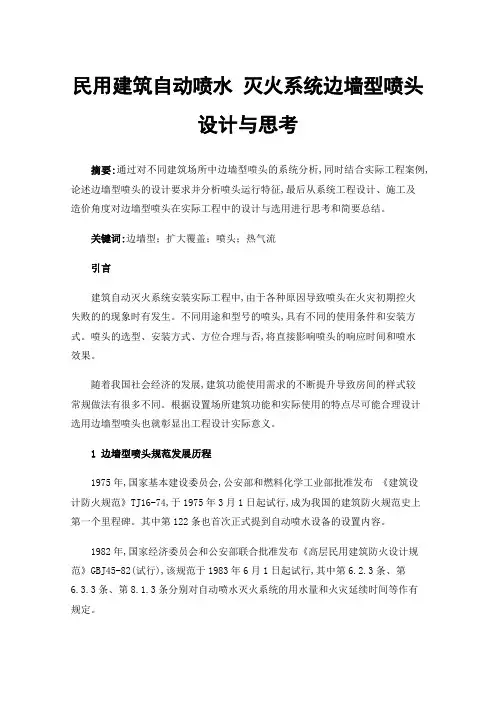
民用建筑自动喷水灭火系统边墙型喷头设计与思考摘要:通过对不同建筑场所中边墙型喷头的系统分析,同时结合实际工程案例,论述边墙型喷头的设计要求并分析喷头运行特征,最后从系统工程设计、施工及造价角度对边墙型喷头在实际工程中的设计与选用进行思考和简要总结。
关键词:边墙型;扩大覆盖;喷头;热气流引言建筑自动灭火系统安装实际工程中,由于各种原因导致喷头在火灾初期控火失败的的现象时有发生。
不同用途和型号的喷头,具有不同的使用条件和安装方式。
喷头的选型、安装方式、方位合理与否,将直接影响喷头的响应时间和喷水效果。
随着我国社会经济的发展,建筑功能使用需求的不断提升导致房间的样式较常规做法有很多不同。
根据设置场所建筑功能和实际使用的特点尽可能合理设计选用边墙型喷头也就彰显出工程设计实际意义。
1边墙型喷头规范发展历程1975年,国家基本建设委员会,公安部和燃料化学工业部批准发布《建筑设计防火规范》TJ16-74,于1975年3月1日起试行,成为我国的建筑防火规范史上第一个里程碑。
其中第122条也首次正式提到自动喷水设备的设置内容。
1982年,国家经济委员会和公安部联合批准发布《高层民用建筑防火设计规范》GBJ45-82(试行),该规范于1983年6月1日起试行,其中第6.2.3条、第6.3.3条、第8.1.3条分别对自动喷水灭火系统的用水量和火灾延续时间等作有规定。
1985年12月6日,国家计划委员会批准发布《自动喷水灭火系统规范》GBJ84-85,该规范于1986年7月1日起施行。
此规范正式对侧墙型喷头作有相关规定。
其中第4.4.1条在吊顶、屋面板、楼板下安装边墙型喷头时,其两侧1米范围内和墙体垂直方向2米范围内,均不应设有障碍物。
第4.4.4条边墙型喷头的布置,宽度介于3.6米至7.2米和房间,应沿房间长向的两侧各布置一排边墙型喷头,宽度大于7.2米的房间,除两侧各布置一排边墙型喷头外,还应按本规范表4.1.1的规定在房间中间布置标准喷头。

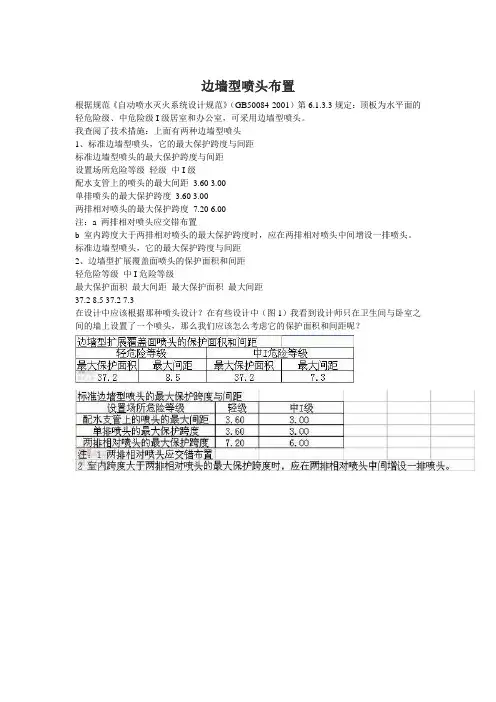
边墙型喷头布置
根据规范《自动喷水灭火系统设计规范》(GB50084-2001)第6.1.3.3规定:顶板为水平面的轻危险级、中危险级I级居室和办公室,可采用边墙型喷头。
我查阅了技术措施:上面有两种边墙型喷头
1、标准边墙型喷头,它的最大保护跨度与间距
标准边墙型喷头的最大保护跨度与间距
设置场所危险等级轻级中I级
配水支管上的喷头的最大间距 3.60 3.00
单排喷头的最大保护跨度3.60 3.00
两排相对喷头的最大保护跨度7.20 6.00
注:a 两排相对喷头应交错布置
b 室内跨度大于两排相对喷头的最大保护跨度时,应在两排相对喷头中间增设一排喷头。
标准边墙型喷头,它的最大保护跨度与间距
2、边墙型扩展覆盖面喷头的保护面积和间距
轻危险等级中I危险等级
最大保护面积最大间距最大保护面积最大间距
37.2 8.5 37.2 7.3
在设计中应该根据那种喷头设计?在有些设计中(图1)我看到设计师只在卫生间与卧室之间的墙上设置了一个喷头,那么我们应该怎么考虑它的保护面积和间距呢?。
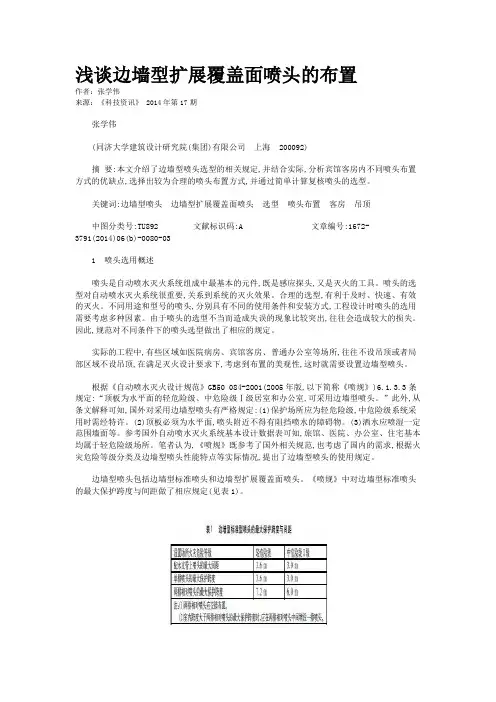
浅谈边墙型扩展覆盖面喷头的布置作者:张学伟来源:《科技资讯》 2014年第17期张学伟(同济大学建筑设计研究院(集团)有限公司上海 200092)摘要:本文介绍了边墙型喷头选型的相关规定,并结合实际,分析宾馆客房内不同喷头布置方式的优缺点,选择出较为合理的喷头布置方式,并通过简单计算复核喷头的选型。
关键词:边墙型喷头边墙型扩展覆盖面喷头选型喷头布置客房吊顶中图分类号:TU892 文献标识码:A 文章编号:1672-3791(2014)06(b)-0080-031 喷头选用概述喷头是自动喷水灭火系统组成中最基本的元件,既是感应探头,又是灭火的工具。
喷头的选型对自动喷水灭火系统很重要,关系到系统的灭火效果。
合理的选型,有利于及时、快速、有效的灭火。
不同用途和型号的喷头,分别具有不同的使用条件和安装方式,工程设计时喷头的选用需要考虑多种因素。
由于喷头的选型不当而造成失误的现象比较突出,往往会造成较大的损失。
因此,规范对不同条件下的喷头选型做出了相应的规定。
实际的工程中,有些区域如医院病房、宾馆客房、普通办公室等场所,往往不设吊顶或者局部区域不设吊顶,在满足灭火设计要求下,考虑到布置的美观性,这时就需要设置边墙型喷头。
根据《自动喷水灭火设计规范》GB50 084-2001(2005年版,以下简称《喷规》)6.1.3.3条规定:“顶板为水平面的轻危险级、中危险级Ⅰ级居室和办公室,可采用边墙型喷头。
”此外,从条文解释可知,国外对采用边墙型喷头有严格规定:(1)保护场所应为轻危险级,中危险级系统采用时需经特许。
(2)顶板必须为水平面,喷头附近不得有阻挡喷水的障碍物。
(3)洒水应喷湿一定范围墙面等。
参考国外自动喷水灭火系统基本设计数据表可知,旅馆、医院、办公室、住宅基本均属于轻危险级场所。
笔者认为,《喷规》既参考了国外相关规范,也考虑了国内的需求,根据火灾危险等级分类及边墙型喷头性能特点等实际情况,提出了边墙型喷头的使用规定。
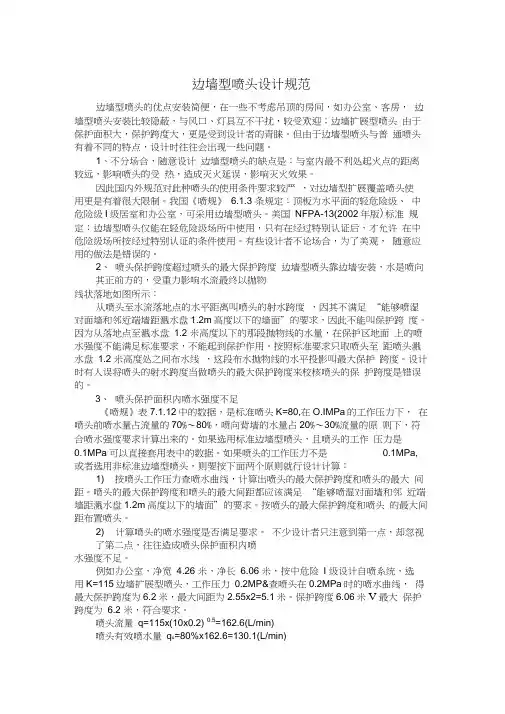
边墙型喷头设计规范边墙型喷头的优点安装简便,在一些不考虑吊顶的房间,如办公室、客房,边墙型喷头安装比较隐蔽,与风口、灯具互不干扰,较受欢迎;边墙扩展型喷头由于保护面积大,保护跨度大,更是受到设计者的青睐。
但由于边墙型喷头与普通喷头有着不同的特点,设计时往往会出现一些问题。
1、不分场合,随意设计边墙型喷头的缺点是:与室内最不利处起火点的距离较远,影响喷头的受热,造成灭火延误,影响灭火效果。
因此国内外规范对此种喷头的使用条件要求较严,对边墙型扩展覆盖喷头使用更是有着很大限制。
我国《喷规》 6.1.3 条规定:顶板为水平面的轻危险级、中危险级I级居室和办公室,可采用边墙型喷头。
美国NFPA-13(2002年版)标准规定:边墙型喷头仅能在轻危险级场所中使用,只有在经过特别认证后,才允许在中危险级场所按经过特别认证的条件使用。
有些设计者不论场合,为了美观,随意应用的做法是错误的。
2、喷头保护跨度超过喷头的最大保护跨度边墙型喷头靠边墙安装,水是喷向其正前方的,受重力影响水流最终以抛物线状落地如图所示:从喷头至水流落地点的水平距离叫喷头的射水跨度,因其不满足“能够喷湿对面墙和邻近端墙距溅水盘1.2m高度以下的墙面”的要求,因此不能叫保护跨度。
因为从落地点至溅水盘 1.2 米高度以下的那段抛物线的水量,在保护区地面上的喷水强度不能满足标准要求,不能起到保护作用。
按照标准要求只取喷头至距喷头溅水盘 1.2 米高度处之间布水线,这段布水抛物线的水平投影叫最大保护跨度。
设计时有人误将喷头的射水跨度当做喷头的最大保护跨度来校核喷头的保护跨度是错误的。
3、喷头保护面积内喷水强度不足《喷规》表7.1.12中的数据,是标准喷头K=80,在O.IMPa的工作压力下,在喷头前喷水量占流量的70%〜80%,喷向背墙的水量占20%〜30%流量的原则下,符合喷水强度要求计算出来的。
如果选用标准边墙型喷头,且喷头的工作压力是0.1MPa可以直接套用表中的数据。
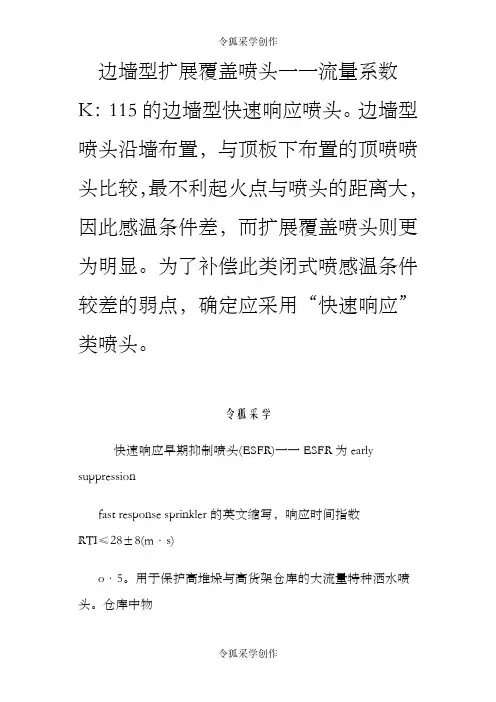
边墙型扩展覆盖喷头一一流量系数K:115的边墙型快速响应喷头。
边墙型喷头沿墙布置,与顶板下布置的顶喷喷头比较,最不利起火点与喷头的距离大,因此感温条件差,而扩展覆盖喷头则更为明显。
为了补偿此类闭式喷感温条件较差的弱点,确定应采用“快速响应”类喷头。
令狐采学快速响应早期抑制喷头(ESFR)一一ESFR为early suppressionfast response sprinkler的英文缩写,响应时间指数RTI≤28±8(m·s)o·5。
用于保护高堆垛与高货架仓库的大流量特种洒水喷头。
仓库中物品的堆积高度大,火灾的竖向蔓延速度快,火灾放热速率的增长速度快,火头的位置不断提高。
此类火灾虽能较为迅速地驱动喷头,但灭火的难度大,堆垛和货架对喷水的遮挡作用大。
此种喷头的特点是,RTI数值小、动作灵敏,工作压力高、喷水的动量大、穿透力强,可增大实际送达燃烧面的灭火水量,使控灭火效果明显增强。
会展中心等物品堆积高度较低的其他类型高大空间场所,由于火焰高度低、烟气上升至顶板的距离大,致使流经喷头的烟气温度低、流速慢,烟气驱动喷头的条件差,而导致喷头动作缓慢。
因此,达到一定高度后,将难以保证喷头的开放时间,以及下喷水量能够有效覆盖火灾区域。
闭式喷头在初期火灾阶段开放,开放喷头的下喷水量有效覆盖起火范围;且送达物品燃烧面的水量大于冷却燃烧面灭火所需求的水量,是闭式系统成功控灭火的三个要素。
闭式喷头能够及时动作并有效覆盖起火范围的场所,其室内净空高度,据国外资料介绍为8~25ft(2.4~7.5m)。
此外,我国(火灾自动报警系统设计规范)规定感温探测器的最大安装高度为8m、感烟探测器的最大安装高度为12m。
为了保证湿式系统的有效性,应控制其应用场所的最大净空高度。
采用湿式系统的场所,其室内最大净空高度不应大于表5的规定。
仅用于保护室内钢屋架等建筑构件、和设置货架内喷头的闭式系统,不受此表规定的限制。
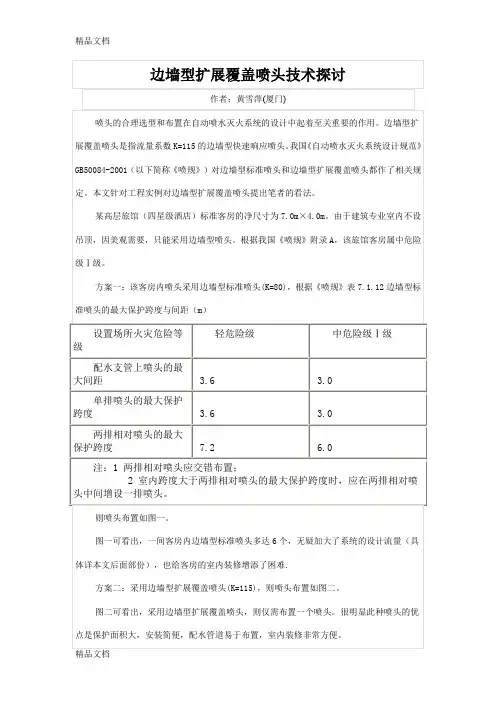
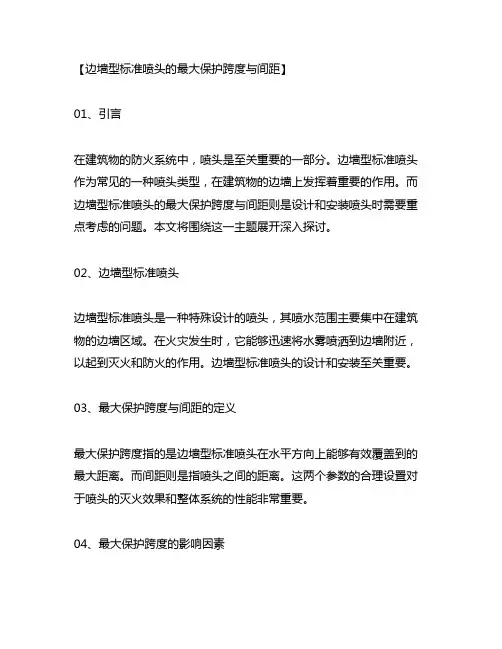
【边墙型标准喷头的最大保护跨度与间距】01、引言在建筑物的防火系统中,喷头是至关重要的一部分。
边墙型标准喷头作为常见的一种喷头类型,在建筑物的边墙上发挥着重要的作用。
而边墙型标准喷头的最大保护跨度与间距则是设计和安装喷头时需要重点考虑的问题。
本文将围绕这一主题展开深入探讨。
02、边墙型标准喷头边墙型标准喷头是一种特殊设计的喷头,其喷水范围主要集中在建筑物的边墙区域。
在火灾发生时,它能够迅速将水雾喷洒到边墙附近,以起到灭火和防火的作用。
边墙型标准喷头的设计和安装至关重要。
03、最大保护跨度与间距的定义最大保护跨度指的是边墙型标准喷头在水平方向上能够有效覆盖到的最大距离。
而间距则是指喷头之间的距离。
这两个参数的合理设置对于喷头的灭火效果和整体系统的性能非常重要。
04、最大保护跨度的影响因素边墙型标准喷头的最大保护跨度受到多种因素的影响。
首先是水压和喷头的设计参数,包括出水口的尺寸和喷头的角度等。
其次是喷头安装的高度、角度和位置,及喷水的流量等。
这些因素共同影响着最大保护跨度的确定。
05、间距的影响因素喷头间距的设置也是至关重要的。
过大的间距会导致喷水范围的空隙,影响喷洒的均匀性和覆盖面积;而过小的间距则会造成资源的浪费和系统的不稳定。
合理设置喷头间距对于保证整个喷水系统的有效性至关重要。
06、个人观点和理解在设计和安装边墙型标准喷头时,我认为需要考虑的因素非常多。
需要充分考虑建筑物的结构、火灾风险、水压情况、喷头品质等多个方面的因素。
而合理设置最大保护跨度和间距,则需要根据实际情况进行综合考量和实地测试,以确保系统的稳定性和可靠性。
07、总结在本文中,我们探讨了边墙型标准喷头的最大保护跨度与间距这一重要主题。
我们了解到了这两个参数对喷头系统的重要意义,以及影响因素和个人观点。
通过对这一主题的深入探讨,相信读者能够对边墙型标准喷头有更深入的了解,并在实际工程中能够更好地应用和调整喷头系统,以确保建筑物的防火安全。

喷头的合理选型和布置在自动喷水灭火系统的设计中起着至关重要的作用。
边墙型扩展覆盖喷头是指流量系数K=115的边墙型快速响应喷头。
我国《自动喷水灭火系统设计规范》GB50084-2001(以下简称《喷规》)对边墙型标准喷头和边墙型扩展覆盖喷头都作了相关规定。
本文针对工程实例对边墙型扩展覆盖喷头提出笔者的看法。
某高层旅馆(四星级酒店)标准客房的净尺寸为7.0m×4.0m。
由于建筑专业室内不设吊顶,因美观需要,只能采用边墙型喷头。
根据我国《喷规》附录A,该旅馆客房属中危险级Ⅰ级。
方案一:该客房内喷头采用边墙型标准喷头(K=80),根据《喷规》表7.1.12边墙型标准喷头的最大保护跨度与间距(m)则喷头布置如图一。
图一可看出,一间客房内边墙型标准喷头多达6个,无疑加大了系统的设计流量(具体详本文后面部份),也给客房的室内装修增添了困难.方案二:采用边墙型扩展覆盖喷头(K=115),则喷头布置如图二。
图二可看出,采用边墙型扩展覆盖喷头,则仅需布置一个喷头。
很明显此种喷头的优点是保护面积大,安装简便,配水管道易于布置,室内装修非常方案二为多数设计单位采用。
但边墙型扩展覆盖喷头尚未纳入国家标准《自动喷水灭火系统洒水喷头性能要求和试验方法》GB5135-95的规定内容之中,《喷规》6.1.3对此仅规定了:“顶板为水平面的轻危险级,中危险级Ⅰ级居室和办公室,可采用边墙型喷头。
”其条文解释则又称国外对采用边墙型扩展覆盖喷头有严格规定:保护场所应为轻危险级,中危险级系统采用时须经特许。
美国NFPA13(1996年版)确实有此规定。
这就给设计人员带来了困惑,高层旅馆客房究竟能否采用边墙型扩展覆盖喷头呢?其实,设置场所火灾危险等级的划分标准各国不尽相同。
英美国家与我国差异较大。
高层旅馆客房在我国属中危险级Ⅰ级,但在英美日德等国均属于轻危险级。
可见高层旅馆客房采用边墙型扩展覆盖喷头在国外也是允许的。
另外,火灾调查发现,许多旅馆客房火灾只有少量的可燃物燃烧,即造成室内人员CO中毒死亡。
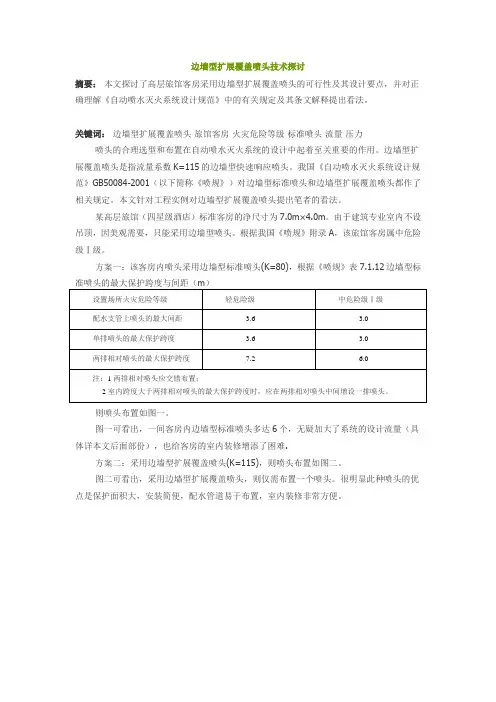
边墙型扩展覆盖喷头技术探讨摘要:本文探讨了高层旅馆客房采用边墙型扩展覆盖喷头的可行性及其设计要点,并对正确理解《自动喷水灭火系统设计规范》中的有关规定及其条文解释提出看法。
关键词:边墙型扩展覆盖喷头旅馆客房火灾危险等级标准喷头流量压力喷头的合理选型和布置在自动喷水灭火系统的设计中起着至关重要的作用。
边墙型扩展覆盖喷头是指流量系数K=115的边墙型快速响应喷头。
我国《自动喷水灭火系统设计规范》GB50084-2001(以下简称《喷规》)对边墙型标准喷头和边墙型扩展覆盖喷头都作了相关规定。
本文针对工程实例对边墙型扩展覆盖喷头提出笔者的看法。
某高层旅馆(四星级酒店)标准客房的净尺寸为7.0m×4.0m。
由于建筑专业室内不设吊顶,因美观需要,只能采用边墙型喷头。
根据我国《喷规》附录A,该旅馆客房属中危险级Ⅰ级。
方案一:该客房内喷头采用边墙型标准喷头(K=80),根据《喷规》表7.1.12边墙型标准喷头的最大保护跨度与间距(m)设置场所火灾危险等级轻危险级中危险级Ⅰ级配水支管上喷头的最大间距 3.6 3.0单排喷头的最大保护跨度 3.6 3.0两排相对喷头的最大保护跨度7.2 6.0注:1 两排相对喷头应交错布置;2 室内跨度大于两排相对喷头的最大保护跨度时,应在两排相对喷头中间增设一排喷头。
则喷头布置如图一。
图一可看出,一间客房内边墙型标准喷头多达6个,无疑加大了系统的设计流量(具体详本文后面部份),也给客房的室内装修增添了困难.方案二:采用边墙型扩展覆盖喷头(K=115),则喷头布置如图二。
图二可看出,采用边墙型扩展覆盖喷头,则仅需布置一个喷头。
很明显此种喷头的优点是保护面积大,安装简便,配水管道易于布置,室内装修非常方便。
图一图二方案二为多数设计单位采用。
但边墙型扩展覆盖喷头尚未纳入国家标准《自动喷水灭火系统洒水喷头性能要求和试验方法》GB5135-95的规定内容之中,《喷规》6.1.3对此仅规定了:“顶板为水平面的轻危险级,中危险级Ⅰ级居室和办公室,可采用边墙型喷头。
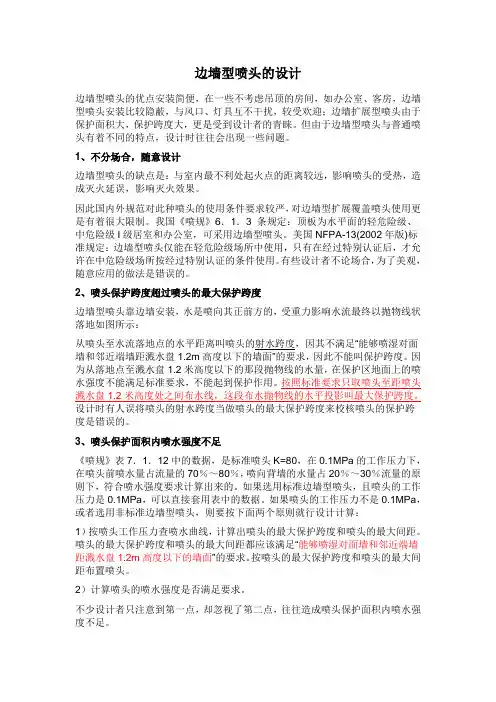
边墙型喷头的设计边墙型喷头的优点安装简便,在一些不考虑吊顶的房间,如办公室、客房,边墙型喷头安装比较隐蔽,与风口、灯具互不干扰,较受欢迎;边墙扩展型喷头由于保护面积大,保护跨度大,更是受到设计者的青睐。
但由于边墙型喷头与普通喷头有着不同的特点,设计时往往会出现一些问题。
1、不分场合,随意设计边墙型喷头的缺点是:与室内最不利处起火点的距离较远,影响喷头的受热,造成灭火延误,影响灭火效果。
因此国内外规范对此种喷头的使用条件要求较严,对边墙型扩展覆盖喷头使用更是有着很大限制。
我国《喷规》6.1.3 条规定:顶板为水平面的轻危险级、中危险级I级居室和办公室,可采用边墙型喷头。
美国NFPA-13(2002年版)标准规定:边墙型喷头仅能在轻危险级场所中使用,只有在经过特别认证后,才允许在中危险级场所按经过特别认证的条件使用。
有些设计者不论场合,为了美观,随意应用的做法是错误的。
2、喷头保护跨度超过喷头的最大保护跨度边墙型喷头靠边墙安装,水是喷向其正前方的,受重力影响水流最终以抛物线状落地如图所示:从喷头至水流落地点的水平距离叫喷头的射水跨度,因其不满足“能够喷湿对面墙和邻近端墙距溅水盘1.2m高度以下的墙面”的要求,因此不能叫保护跨度。
因为从落地点至溅水盘1.2米高度以下的那段抛物线的水量,在保护区地面上的喷水强度不能满足标准要求,不能起到保护作用。
按照标准要求只取喷头至距喷头溅水盘1.2米高度处之间布水线,这段布水抛物线的水平投影叫最大保护跨度。
设计时有人误将喷头的射水跨度当做喷头的最大保护跨度来校核喷头的保护跨度是错误的。
3、喷头保护面积内喷水强度不足《喷规》表7.1.12中的数据,是标准喷头K=80,在0.1MPa的工作压力下,在喷头前喷水量占流量的70%~80%,喷向背墙的水量占20%~30%流量的原则下,符合喷水强度要求计算出来的。
如果选用标准边墙型喷头,且喷头的工作压力是0.1MPa,可以直接套用表中的数据。
边墙型喷头设计规范欧阳家百(2021.03.07)边墙型喷头的优点安装简便,在一些不考虑吊顶的房间,如办公室、客房,边墙型喷头安装比较隐蔽,与风口、灯具互不干扰,较受欢迎;边墙扩展型喷头由于保护面积大,保护跨度大,更是受到设计者的青睐。
但由于边墙型喷头与普通喷头有着不同的特点,设计时往往会出现一些问题。
1、不分场合,随意设计边墙型喷头的缺点是:与室内最不利处起火点的距离较远,影响喷头的受热,造成灭火延误,影响灭火效果。
因此国内外规范对此种喷头的使用条件要求较严,对边墙型扩展覆盖喷头使用更是有着很大限制。
我国《喷规》6.1.3条规定:顶板为水平面的轻危险级、中危险级I级居室和办公室,可采用边墙型喷头。
美国NFPA-13(2002年版)标准规定:边墙型喷头仅能在轻危险级场所中使用,只有在经过特别认证后,才允许在中危险级场所按经过特别认证的条件使用。
有些设计者不论场合,为了美观,随意应用的做法是错误的。
2、喷头保护跨度超过喷头的最大保护跨度边墙型喷头靠边墙安装,水是喷向其正前方的,受重力影响水流最终以抛物线状落地如图所示:从喷头至水流落地点的水平距离叫喷头的射水跨度,因其不满足“能够喷湿对面墙和邻近端墙距溅水盘1.2m高度以下的墙面”的要求,因此不能叫保护跨度。
因为从落地点至溅水盘1.2米高度以下的那段抛物线的水量,在保护区地面上的喷水强度不能满足标准要求,不能起到保护作用。
按照标准要求只取喷头至距喷头溅水盘1.2米高度处之间布水线,这段布水抛物线的水平投影叫最大保护跨度。
设计时有人误将喷头的射水跨度当做喷头的最大保护跨度来校核喷头的保护跨度是错误的。
3、喷头保护面积内喷水强度不足《喷规》表7.1.12中的数据,是标准喷头K=80,在0.1MPa 的工作压力下,在喷头前喷水量占流量的70%~80%,喷向背墙的水量占20%~30%流量的原则下,符合喷水强度要求计算出来的。
如果选用标准边墙型喷头,且喷头的工作压力是0.1MPa,可以直接套用表中的数据。
(英文版)Two regulations promulgated for implementation is in the party in power for a long time and the rule of law conditions, the implementation of comprehensive strictly strategic plan, implementation in accordance with the rules and discipline to manage the party, strengthen inner-party supervision of major initiatives. The two regulations supporting each other, the < code > adhere to a positive advocate, focusing on morality is of Party members and Party leading cadres can see, enough to get a high standard; < rule > around the party discipline, disciplinary ruler requirements, listed as "negative list, focusing on vertical gauge, draw the party organizations and Party members do not touch the" bottom line ". Here, the main from four square face two party rules of interpretation: the first part introduces two party Revised regulations the necessity and the revision process; the second part is the interpretation of the two fundamental principles of the revision of laws and regulations in the party; the third part introduces two party regulations modified the main changes and needs to grasp several key problems; the fourth part on how to grasp the implementation of the two regulations of the party. < code > and < Regulations > revised the necessity and revisedhistory of the CPC Central Committee the amendment to the Chinese Communist Party members and leading cadres honest politics several guidelines > and < Chinese Communist Party discipline and Punishment Regulations > column 1 by 2015 to strengthen party laws and regulations focus. Two party regulations revision work lasted a Years, pooling the wisdom of the whole party, ideological consensus, draw historical experience, respect for the wisdom of our predecessors, which reflects the unity of inheritance and innovation; follow the correct direction, grasp the limited goals, adhere to the party's leadership, to solve the masses of the people reflect a focus on the problem. The new revision of the < code > and < rule >, reflects the party's 18 and the eighth session of the third, the spirit of the fourth plenary session, reflecting the experience of studying and implementing the General Secretary Xi Jinping series of important speech, reflects the party's eighteen years comprehensive strictly practice. (a) revised two regulations of the party need of < the ICAC guidelines > in < in 1997 Leaders as members of the Communist Party of China clean politics certain criteria (Trial) > based on revised, the promulgation and implementation of January 2010, to strengthen the construction of the contingent of leading cadres play animportant role. But with the party to manage the party strictly administering the deepening, has not been able to fully meet the actual needs. Content is too complicated, "eight prohibition, 52 are not allowed to" hard to remember, and also difficult to put into practice; the second is concisely positive advocated by the lack of prohibited provisions excessive, no autonomy requirements; the third is banned terms and discipline law, both with the party discipline, disciplinary regulations repeat and Criminal law and other laws and regulations repeat; the fourth is to "clean" the theme is not prominent, not for the existing problems, and is narrow, only needle of county-level leading cadres above. < rule > is in 1997 < Chinese Communist Party disciplinary cases (Trial) > based on revision, in December 2003 the promulgation and implementation, to strengthen the construction of the party play very important role. Along with the development of the situation, which many provisions have been unable to fully meet the comprehensive strictly administering the practice needs. One is Ji law, more than half of the provisions and criminal law and other countries laws and regulations Repetition; two is the political discipline regulations is not prominent, not specific, for violation of the party constitution, damage theauthority of Party Constitution of misconduct lack necessary and serious responsibility to pursue; third is the main discipline for the leading cadres, does not cover all Party members. Based on the above situation, need to < the criterion of a clean and honest administration > and < rule > the two is likely to be more relevant regulations first amendment. By revising, really put the authority of Party discipline, the seriousness in the party tree and call up the majority of Party members and cadres of the party constitution of party compasses party consciousness. (II) two party regulations revision process the Central Committee of the Communist Party of China attaches great importance to two regulations revision . Xi Jinping, general books recorded in the Fifth Plenary Session of the eighth session of the Central Commission for Discipline Inspection, on the revised regulations < > made clear instructions. According to the central deployment, the Central Commission for Discipline Inspection from 2014 under six months begin study two regulations revision. The Standing Committee of the Central Commission for Discipline Inspection 4 review revised. Comrade Wang Qishan 14 times held a special meeting to study two regulations revision, amendment clarifies the direction, major issues of principle, path and target,respectively held a forum will listen to part of the province (area) secretary of the Party committee, Secretary of the Discipline Inspection Commission, part of the central ministries and state organs DepartmentThe first party committee is mainly responsible for people, views of experts and scholars and grassroots party organizations and Party members. Approved by the Central Committee of the Communist Party of China, on 7 September 2015, the general office of the Central Committee of the Party issued a notice to solicit the provinces (autonomous regions, municipalities) Party, the central ministries and commissions, state ministries and commissions of the Party (party), the General Political Department of the military, every 3 people organization of Party of two regulations revision opinion. Central Commission for Discipline Inspection of extensive solicitation of opinions, careful study, attracting, formed a revised sent reviewers. In October 8 and October 12, Central Committee Political Bureau Standing Committee and the Political Bureau of the Central Committee After consideration of the two regulations revised draft. On October 18, the Central Committee of the Communist Party of China formally issued two regulations. Can say, two laws amendment concentrated thewisdom of the whole party, embodies the party. Second, < code > and < Regulations > revision of the basic principles of two party regulations revision work and implement the party's eighteen, ten eight plenary, the spirit of the Fourth Plenary Session of the Eleventh Central Committee and General Secretary Xi Jinping important instructions on the revised < low political criterion > and < Regulations >, highlighting the ruling party characteristics, serious discipline, the discipline quite in front of the law, based on the current, a long-term, advance as a whole, with Bu Xiuding independent < rule > and < rule >. Main principle is: first, adhere to the party constitution to follow. The constitution about discipline and self-discipline required specific, awaken the party constitution of party compasses party consciousness, maintaining the authority of the constitution. General Secretary Xi Jinping pointed out that "no rules, no side round. Party constitution is the fundamental law, the party must follow the general rules. In early 2015 held the eighth session of the Central Commission for Discipline Inspection Fifth Plenary Session of the 16th Central Committee, Xi Jinping again pointed out that constitution is the party must follow the general rules, but also the general rules." the revision of the< code > and < rule > is Method in adhere to the regulations established for the purpose of combining rule of virtue is to adhere to the party constitution as a fundamental to follow, the constitution authority set up, wake up the party constitution and party rules the sense of discipline, the party constitution about discipline and self-discipline specific requirements. 4 second is to adhere to in accordance with the regulations governing the party and the party. The Party of rule of virtue "de", mainly refers to the party's ideals and beliefs, excellent traditional style. The revised the < code > closely linked to the "self-discipline", insisting on the positive initiative, for all members, highlight the "vital few", emphasized self-discipline, focusing on the morality, and the majority of Party members and the ideological and moral standards. The revised < > Ji method separately, Ji, Ji Yan to Method, as a "negative list", emphasizing the heteronomy, focusing on vertical gauge. Is this one high and one low, a positive reaction, the strict party discipline and practice results transformation for the integration of the whole party to observe moral and discipline requirements, for the majority of Party members and cadres provides benchmarking and ruler. Third, insist on to. In view of the problems existing in theparty at the present stage, the main problems of Party members and cadres in the aspect of self-discipline and abide by the discipline to make clearly defined, especially the party's eighteen years strict political discipline and political rules, organization and discipline and to implement the central eight provisions of the spirit against the four winds and other requirements into Disciplinary provisions. Not one pace reachs the designated position, focusing on in line with reality, pragmatic and effective. After the revision of major changes, major changes in the < code > and < rule > modified and needs to grasp several key problems (a) < code > < code > adhere to according to regulations governing the party and party with morals in combination, for at the present stage, the leadership of the party members and cadres and Party members in existing main problems of self-discipline, put forward principles, requirements and specifications, showing Communists noble moral pursuit, reflected at all times and in all over the world ethics from high from low 5 common requirements. One is closely linked to the "self-discipline", removal and no direct relation to the provisions of . the second is adhere to a positive advocate, "eight prohibition" 52 are not allowed to "about the content of the" negative list moved into synchronizationamendment < cases >. Three is for all the party members, will apply object from the leadership of the party members and cadres to expand to all Party members, fully embodies the comprehensive strictly required. The fourth is prominent key minority, seize the leadership of the party members and cadres is the key, and put forward higher requirements than the ordinary Party members. Five is to simplify, and strive to achieve concise, easy to understand, easy to remember. The revised < code > is the ruling Party since the first insists on a positive advocate forAll Party members and the self-discipline norms, moral declaration issued to all members of the party and the National People's solemn commitment. > < criterion of a clean and honest administration consists of 4 parts, 18, more than 3600 words. After the revision of the < code >, a total of eight, 281 words, including lead, specification and Party member cadre clean fingered self-discipline norms, etc. Part 3 members low-cost clean and self-discipline, the main contents can be summarized as "four must" "eight code". Lead part, reiterated on ideal and faith, fundamental purpose, the fine traditions and work style, noble sentiments, such as "four must" the principle of requirements, strong tone of self-discipline, The higher request for 6 andsupervised tenet, the foothold in permanent Bao the party's advanced nature and purity, to reflect the revised standards requirements. Members of self-discipline norms around the party members how to correctly treat and deal with the "public and private", "cheap and rot" thrifty and extravagance "bitter music", put forward the "four norms". Party leader cadre clean fingered self-discipline norms for the leadership of the party members and cadres of the "vital few", around the "clean politics", from civil servant of the color, the exercise of power, moral integrity, a good family tradition and other aspects of the leadership of the party members and cadres of the "four norms" < > < norm norm. "The Party member's self-discipline norms" and "party members and leading cadre clean fingered self-discipline norms," a total of eight, collectively referred to as the "eight". "Four must" and "eight" of the content from the party constitution and Party's several generation of leaders, especially Xi Jinping, general secretary of the important discussion, refer to the "three discipline and eight points for attention" statements, and reference some embody the Chinese nation excellent traditional culture essence of epigrams. (2) the revised regulations, the main changes in the revised Regulations > to fully adapt to thestrictly requirements, reflects the according to the regulations governing the law of recognition of deepening, the realization of the discipline construction and Jin Ju. < rule > is party a ruler, members of the basic line and follow. And the majority of Party members and cadres of Party organizations at all levels should adhere to the bottom line of thinking, fear discipline, hold the bottom line, as a preventive measure, to keep the party's advanced nature and purity. 1, respect for the constitution, refinement and discipline. Revised < rule > from comprehensive comb physical constitution began, the party constitution and other regulations of the Party of Party organizations and Party discipline requirements refinement, clearly defined in violation of the party constitution will be in accordance with regulations to give the corresponding disciplinary action. The original 10 categories of misconduct, integration specification for political discipline, discipline, honesty and discipline masses Ji Law and discipline and discipline and other six categories, the content of < rule > real return to Party discipline, for the majority of Party members and listed a "negative list. 7 2, highlighting the political discipline and political rules. > < Regulations according to the stage of the discipline of outstandingperformance, emphasizing political discipline and political rules, organization and discipline, in opposition to the party's leadership and the party's basic theory, basic line, basic program and basic experience, the basic requirement of behavior made prescribed punishment, increase the cliques, against the organization such as violation of the provisions, to ensure that the central government decrees and the Party of centralized and unified. 3, adhere to strict discipline in the law and discipline In front, Ji separated. Revised < Regulations > adhere to the problem oriented, do Ji separated. Any national law existing content, will not repeat the provisions, the total removal of 79 and criminal law, repeat the content of the public security management punishment law, and other laws and regulations. In the general reiterated that party organizations and Party members must conscientiously accept the party's discipline, die van comply with national laws and regulations; at the same time, to investigate violations of Party members and even criminal behavior of Party discipline and responsibility, > < Regulations distinguish five different conditions, with special provisions were made provisions, so as to realize the connection of Party discipline and state law. 4, reflect Wind building and anti-corruptionstruggle of the latest achievements. < rule > the party's eighteen years implement the spirit of the central provisions of the eight, against the requirements of the "four winds" and transformation for disciplinary provisions, reflecting the style construction is always on the road, not a gust of wind. In the fight against corruption out of new problems, increase the trading rights, the use of authority relatives profit and other disciplinary terms. Prominent discipline of the masses, the new against the interests of the masses and ignore the demands of the masses and other disciplinary terms and make provisions of the disposition and the destruction of the party's close ties with the masses.Discipline to protect the party's purpose. 8 of these regulations, a total of three series, Chapter 15, 178, more than 24000 words, after the revision of the regulations a total of 3 series, Chapter 11, 133, 17000 words, divided into "general" and "special provisions" and "Supplementary Provisions" Part 3. Among them, add, delete, modify the provisions of the proportion of up to nearly 90%. 1, the general general is divided into five chapters. The first chapter to the regulations of the guiding ideology, principles and scope of application of the provisions, highlight the strengthening ofthe party constitution consciousness, maintenance the authority of Party Constitution, increase the party organizations and Party members must abide by the party constitution, Yan Centralized centralized, would examine at all levels of the amended provisions implementing and maintaining Party discipline, and consciously accept the party discipline, exemplary compliance with national laws and regulations. The second chapter of discipline concept, disciplinary action types and effects of the regulations, will be a serious warning from the original a year for a year and a half; increase the Party Congress representative, by leaving the party above (including leave probation) punishment, the party organization should be terminated its representative qualification provisions. The third chapter of the disciplinary rules of use prescribed in the discipline rectifying process, non convergence, not close hand classified as severely or heavier punishment. "Discipline straighten "At least eighteen years of five years, these five years is to pay close attention to the provisions of the central eight implementation and anti -" four winds ". The fourth chapter on suspicion of illegal party disciplinary distinguish five different conditions, with special provisions were madeprovisions, to achieve effective convergence of Party and country 9 method. < rule > the provisions of Article 27, Party organizations in the disciplinary review found that party members have committed embezzlement, bribery, dereliction of duty dereliction of duty and other criminal law act is suspected of committing a crime shall give cancel party posts, probation or expelled from the party. The second is < Regulations > Article 28 the provisions of Party organizations in the disciplinary review But found that party members are stipulated in the criminal law, although not involved in a crime shall be investigated for Party discipline and responsibility should be depending on the specific circumstances shall be given a warning until expelled punishment. This situation and a difference is that the former regulation behavior has been suspected of a crime, the feeling is quite strict, and the latter for the behavior not involving crime, only the objective performance of the provisions of the criminal code of behavior, but the plot is a crime to slightly. < Regulations > the 29 provisions, Party organizations in the discipline review found that party members and other illegal behavior, affect the party's image, the damage to the party, the state and the people's interests, we should depend on the situationSeriousness given disciplinary action. The loss of Party members, seriously damaging the party's image of behavior, should be given expelled from the party. At this article is party member is in violation of the criminal law outside the other illegal acts, such as violates the public security administration punishment law, customs law, financial laws and regulations behavior. The fourth is < cases > Article 32 stipulates, minor party members and the circumstances of the crime, the people's Procuratorate shall make a decision not to initiate a prosecution, or the people's court shall make a conviction and exempted from criminal punishment shall be given within the party is removed from his post, probation or expelled from the party. Party members and crime, sheets were fined in accordance with For acts; the principal Ordinance amended the provisions of the preceding paragraph. This is the new content, in order to achieve Ji method effective convergence. Five is < > the thirty third article 10 of the provisions, the Party member due to an intentional crime is sentenced to criminal law (including probation) sheets or additional deprivation of political rights; due to negligence crime and was sentenced to three years or more (excluding three years) a penalty, shall give expelled punishment. Due to negligence crime is convictedand sentenced to three years (including three years) in prison or be sentenced to public surveillance, detention, shall in general be expelled from the party. For the individual may not be expelled from the party, should control Approval. This is followed and retained the original > < Regulations the provisions of punishment party authorization rules and report to a level party organizations. For is "party members with criminal acts, and by the criminal punishment, generally should be expelled from the party". The fifth chapter of probationary Party member of the discipline and discipline after missing members of the treatment and punishment decisions, such as the implementation of the provisions, clear the related party discipline and punishment decision made after, for duties, wages and other relevant alteration formalities for the longest time. 2, sub sub section will the original regulations of10 categories of acts of violation of discipline integration revised into 6 categories, respectively, in violation of the punishments for acts of political discipline "in violation of discipline behavior of punishment" in violation of integrity of disciplinary action points "of violation punishments for acts of mass discipline" "the violation of work discipline, punishment" in violation of discipline of life behaviorpunishment "6 chapters. 3, annex" Supplementary Provisions "clear authority making supplementary provisions of, cases of interpretative organ, as well as regulations implementation time and retroactivity etc.. 11 (3) learning understanding > < regulations needs to grasp several key problems The first problem -- about the violation of political discipline behavior > < new ordinance chapter 6 the political discipline column for the six disciplines, that is the main opposition to Party leadership and the opposition of the basic theory, basic line, basic program and basic experience, basic requirements of misconduct made provisions of the disposition, especially the eighteen since the CPC Central Committee put forward the Yan Mingzheng treatment of discipline and political rules requirements and practical achievements transformation for Discipline article, increase the false debate central policies, cliques, against the organization review, make no discipline of the principle of harmony terms. These are the party's eighteen years in comprehensive strictly Process combined with the practice of rich content. (1) false debate the central policies and undermine the Party of centralized and unified the problem is made in accordance with the provisions of the party constitution. Constitution in general programme requirementsadhere to democratic centralism is one of the requirements of the construction of the party must adhere to the four cardinal. Application of this principle is not only the party the basic organization principle and is also the mass line in party life, it requires that we must fully develop inner-party democracy, respect for the dominant position of Party members, safeguarding the Party member democratic rights, give full play to the enthusiasm and creativity of the party organizations at all levels and Party members, at the same time, also must implement the right concentration, ensure the party's mission < the chaos in unity and concerted action to ensure that the party's decision to get quickly and effectively implementing. The Party Central Committee formulated the major principles and policies, through different channels and ways, fully listen to the party organizations and Party members of the opinions and suggestions, but 12 is some people face to face not to say back blather "" will not say, after the meeting said, "" Taiwan does not say, and nonsense ", in fact, not only disrupt the people thought, some causing serious consequences, the damage to the Party of the centralized and unified, hinder the central policy implementation, but also a serious violation of the democratic system of principles. There is no doubt that shall, inaccordance with the Regulations > 4 Specified in Article 6 to give the appropriate punishment. For did not cause serious consequences, to give criticism and education or the corresponding tissue processing. (2) about the destruction of the party's unity < New Regulations > the forty eighth to fifty second article, to damage Party's unity unified and violation of political discipline, punishment situation made explicit provisions. Article 52 of the new "in the party get round group, gangs seek private gain, cliques, cultivate private forces or through the exchange of interests, for their own to create momentum and other activities to gain political capital, given a serious warning or withdraw from their party posts disposition; if the circumstances are serious, to give Leave a party to observation or expelled from the party. (3) on against the organization review of the provisions of the constitution, party loyalty honesty is party members must comply with the obligations. Members must obey the organization decision, shall not violate the organization decided encounters by asking questions to find organization, rely on the organization, shall not deceive the organization, against the organization. For example, after the investigation does not take the initiative to explain the situation, but to engage inoffensive and defensive alliance, hiding the stolen money is against survey organization, is a violation of the behavior of political discipline. Article 24 of the original > < Regulations, although the provisions of the interference, hinder group review the behavior of the fabric can be severely or 13 Aggravated punishment, but did not put this kind of behavior alone as a discipline for qualitative amount of discipline. > < new regulations increase the Article 57, "anti organization review, one of the following acts, given a warning or serious warning; if the circumstances are relatively serious, giving removed from or placed on probation within the party post; if the circumstances are serious, give expelled from the party: (a) on supply or forged, destroyed, transfer, conceal evidence; (II) to prevent others expose, providing evidence Material; (III) harboring co personnel; (4) to the organization to provide false information, to hide the fact;(5) the him against the acts of the organization review. "< rule > add this clause to the Constitution requires more specific, the previous no punishment in accordance with the definite list and put forward clear punishment in accordance with. (4) about organizing or participating in superstitious activities as < Regulations > about engage in activities of。
浅谈高层酒店客房中喷头布置优化引言随着国民经济快速发展,人民的幸福指数和收入水平越来越高,出行旅游越来越多。
在这样的大环境下,各类星级酒店应运而生,而酒店的装修设计势必要给消费者好的观感,特别是高档酒店。
如果采用普通吊顶型喷头,不仅会拉低客房的空间高度,也会与吊顶上灯具等设施产生碰撞,影响客房的观感及品质。
所以本文从不同角度探讨边墙型喷头在客房内的布置。
1喷头布置依据和参数选择本文主要针对高层酒店的客房进行探讨,根据GB50084—20XX 自动喷水灭火系统设计规范(以下简称“自喷规范”)第6.1.3条得知,顶板为水平面的中危险级Ⅰ级旅馆建筑客房,可采用边墙型洒水喷头也可采用扩大覆盖面积洒水喷头。
另外根据自喷规范的附录A及5.0.1条可知,高层酒店的客房的火灾危险等级为中危险级Ⅰ级,喷水强度为6L/(min•m2)。
本文以某高层酒店客房的为例,尺寸为9.55m×4.25m,客房休息区尺寸为5.80m×4.25m(如图1所示)。
当高层酒店客房采用边墙型标准覆盖面积洒水喷头(K=80)时,相关设计参数应符合表1的规定。
当高层酒店客房采用边墙型扩大覆盖面积洒水喷头(K=115)时,依自喷规范7.1.5条可知,喷头最大保护跨度和配水支管上的洒水喷头间距,应按洒水喷头工作压力下能够喷湿对面墙和邻近端墙距溅水盘1.2m高度以下的墙面确定。
采用此喷头可根据国家图集《自动喷水与水喷雾灭火设施安装》(图集号04S206)第54页的布水曲线可得表2。
2以实例进行喷头的选型和布置根据客房内休息区的布局,得出以下四个方案,方案一、二在客房内采用标准边墙型喷头,喷头工作压力为0.05MPa。
两个方案在房间中分别沿短边和长边布置喷头,见图2,图3。
方案三、四在客房内采用边墙型扩大覆盖面积洒水喷头。
其中方案三的喷头工作压力为0.20MPa,在房间中沿短边一侧布置了1个喷头(见图4),方案四的喷头工作压力为0.10MPa,在房间中沿长边一侧布置2个喷头(见图5)。
边墙型喷头的设计选型【摘要】自动喷水灭火系统在我国兴起时间较短,自喷系统中的边墙型喷头及覆盖面扩展型喷头更是在近几年才被认可,但它们应该如何设计使用还存在较大的争议。
本文希望通过一些数据的比较和讨论,让大家更关注边墙型喷头及覆盖面扩展型喷头设计中存在的一些问题。
标签边墙型喷头;边墙型扩展覆盖面喷头引言自动喷水灭火系统是随着19世纪工业化革命,首先在英国以穿孔管的形式诞生,应用在剧院,其后在美国应用在棉纺织工业,并逐渐发展成为系统完整、组件齐全的高效全天候的自动灭火系统。
现已广泛应用于工业和民用建筑中,以及居住建筑。
我国自喷系统发展相对较晚,改革开放以来因综合国力的不断提高,自动喷水系统在工程中已普遍应用。
但由于设计依据的缺失或滞后,使得自喷系统的设计存在或多或少的问题,像边墙覆盖面扩展型喷头的设计应用就存在较大的争议。
1.边墙型喷头的种类及性能参数:边墙型喷头是由于安装条件受限,而由普通喷头衍生出来的一种特殊喷头。
边墙型喷头不像普通喷头那样布置在保护区域内部,而是沿保护区域的一边或两边布置,通过向保护区域内喷水起到灭火的作用。
边墙型喷头大致可分为直立边墙型喷头、水平边墙型喷头和边墙型扩展覆盖面喷头三种。
表1-1、1-2是三类边墙型喷头在不同工作压力下的性能参数。
从表中不难看出,相同工作压力下,三种喷头的主要差异是喷水范围和喷水强度的不同。
而同种喷头又因为工作压力的不同有着不同的喷水范围和强度。
2.边墙型喷头的相关规范:现阶段我国施工图设计主要以《自动喷水灭火系统设计规范》GB50084-2001(2005年版)为自喷系统的设计依据。
《自动喷水灭火系统设计规范》中涉及边墙型喷头的条文主要有以下三条:(1)7.1.12条:边墙型标准喷头的最大保护跨度与间距,应符合下表的规定:(2)7.1.13条:边墙型扩展覆盖喷头的最大保护跨度、配水支管上的喷头间距、喷头与两侧端墙的距离,应按喷头工作压力下能够喷湿对面墙和邻近端墙距溅水盘 1.2m高度以下的墙面确定,且保护面积内的喷水强度应符合本规范表5.0.1的规定。
边墙型喷头设计规范一、设计原则:1.结构合理:边墙型喷头的设计应符合力学原理,能够承受所需水压,具有良好的水流控制性能。
2.安全可靠:边墙型喷头的设计应满足安全可靠的要求,能够防止水流溅射至人体或周围环境,防止喷头倒塌或损坏。
3.美观大方:边墙型喷头的设计应注重形态美观,与建筑物或景观墙融为一体,不影响整体效果。
二、材料选择:1.不锈钢:边墙型喷头主体结构可以选择不锈钢材料,具有较好的耐腐蚀性和抗氧化性能,能够长期使用。
2.铝合金:边墙型喷头的喷水口和水管可以选择铝合金材料,具有轻量化、耐用性强的特点。
3.强化玻璃:边墙型喷头的面板可以选择强化玻璃材料,具有高透明度和强度,能够使喷水效果更加清晰明亮。
三、安装要求:1.安全固定:边墙型喷头在安装过程中应采取加固措施,确保其能够牢固地固定在建筑物外墙或景观墙上,不会产生倾斜或松动。
2.水管布置合理:边墙型喷头的水管布置应合理,避免过长或过短,以免影响水流效果,同时要保证管道与墙体之间的连接处不会出现漏水现象。
3.排水设施:边墙型喷头设计时应考虑排水设施,确保喷水后的水能够及时排出,避免积水产生滑倒或腐蚀等问题。
四、性能要求:1.喷水形式:边墙型喷头设计应具有多种喷水形式,如直流、旋转、喷雾等,以满足不同场景的需求。
2.水流控制:边墙型喷头应具有良好的水流控制性能,能够调节喷水的高度、强度和角度等参数。
3.节水环保:边墙型喷头应具有节水环保的特点,能够有效利用水源,并在不使用时能够自动关闭或停止供水。
五、维护保养:1.定期检查:边墙型喷头在安装后应定期检查、清洗和维护,发现问题及时解决,确保其正常运行。
2.防冻措施:对于寒冷地区的边墙型喷头,应采取防冻措施,避免冬季管道冻裂或设备损坏。
3.防止堵塞:边墙型喷头的水管应注意防止杂物进入,避免堵塞水流。
在设计边墙型喷头时,需要综合考虑建筑物、景观墙的整体效果和功能需求,合理安排喷头的类型、数量和布局。
同时,设计人员应密切关注安全性、耐久性、美观性和环保性等因素,确保边墙型喷头在使用过程中能够长久运行、安全可靠,并达到预期的喷水效果。
宾馆客房边墙型喷头的设计应用摘要:边墙型喷头因其配水管道易于布置,颇受设计、施工及使用单位的欢迎。
但是对于边墙型喷头的应用却是有严格的规定,使得设计及使用中存在一定的限制。
本文就某一高层宾馆客房采用边墙型喷头进行可行性及设计应用进行分析。
关键词:高层宾馆客房边墙型喷头扩展覆盖喷头选择合适的喷头型式,并且进行合理的平面布置,是自动喷水灭火系统设计中至关重要的步骤。
设计案例:扬州某高层宾馆,层数13层,每层30间客房。
为了空间的视觉效果,装修标准为客房内起居部分不做吊顶。
一、客房内喷头的选择由于客房内起居部分不设置吊顶,因此在此部分不适合设置直立喷头或下垂型喷头。
1、喷头型式的选择根据《自动喷水灭火系统设计规范》(GB50084-2001,2005年版)6.1.3.3条“顶板为水平面的轻危险级、中危险级I级居室和办公室,可采用边墙型喷头”。
由此可见,使用边墙型喷头的场所,既要满足自动喷水灭火系统设置的火灾危险等级的要求,又要满足使用空间的要求。
从对设置场所危险等级的分类以及边墙型喷头性能特点等实际情况,既允许使用又严格了使用条件,使用时必须同时满足以下三个条件方能使用边墙型喷头:1)所使用的场所必须是轻危险级或中危险级I级。
2)所使用的空间只能是居室或办公室。
3)所使用空间处的顶板必须是水平面,喷头附近不得有阻挡喷水的障碍物。
本工程为高层宾馆,其自动喷水灭火系统的设置危险等级为中危险级I级,满足条件1。
设置场所为客房内,客房空间属于居住空间,满足条件2。
客房内起居部分不设置吊顶,顶板为水平面,满足条件3。
因此本工程客房内满足设置边墙型喷头的条件,选择边墙型喷头。
2、标准型和扩展覆盖型喷头的选择边墙型喷头有标准型和扩展覆盖型两种。
对于标准边墙型喷头,现行《自动喷水灭火系统设计规范》中对喷头的最大保护跨度及最大间距作了明确规定,如下表。
它是按70%的水量向喷头前方喷洒,30%的水量向喷头的后面墙上喷洒,并符合喷水强度要求而定的。
Icix浅谈边墙型喷头的设计
浙江晟元建筑设计有限公司王忠举
边墙型喷头的优点安装简便,在一些不考虑吊顶的房间,如办公室、客房,边墙型喷头安装比较隐蔽,与风口、灯具互不干扰,较受欢迎;边墙扩展型喷头由于保护面积大,保护跨度大,更是受到设计者的青睐。
但由于边墙型喷头与普通喷头有着不同的特点,设计时往往会出现一些问题。
1、不分场合,随意设计
边墙型喷头的缺点是:与室内最不利处起火点的距离较远,影响喷头的受热,造成灭火延误,影响灭火效果。
因此国内外规范对此种喷头的使用条件要求较严,对边墙型扩展覆盖喷头使用更是有着很大限制。
我国《喷规》6.1.3条规定:顶板为水平面的轻危险级、中危险级I 级居室和办公室,可采用边墙型喷头.美国NFPA-13(2002年版)标准规定:边墙型喷头仅能在轻危险级场所中使用,只有在经过特别认证后,才允许在中危险级场所按经过特别认证的条件使用.有些设计者不论场合,为了美观,随意应用的做法是错误的。
2、喷头保护跨度超过喷头的最大保护跨度
边墙型喷头靠边墙安装,水是喷向其正前方的,受重力影响水流最终以抛物线状落地如图所示:
从喷头至水流落地点的水平距离叫喷头的射水跨度,因其不满足“能够喷湿对面墙和邻近端墙距溅水盘1。
2m高度以下的墙面”的要求,因此不能叫保护跨度。
因为从落地点至溅水盘1.2米高度以下的那段抛物线的水量,在保护区地面上的喷水强度不能满足标准要求,不能起到保护作用。
按照标准要求只取喷头至距喷头溅水盘1.2米高度处之间布水线,这段布水抛物线的水平投影叫最大保护跨度。
设计时有人误将喷头的射水跨度当做喷头的最大保护跨度来校核喷头的保护跨度是错误的.
3、喷头保护面积内喷水强度不足
《喷规》表7.1.12中的数据,是标准喷头K=80,在0.1MPa的工作压力下,在喷头前喷水量占流量的70%~80%,喷向背墙的水量占20%~30%流量的原则下,符合喷水强度要求计算出来的。
如果选用标准边墙型喷头,且喷头的工作压力是0.1MPa,可以直接套用表中的数据。
如果喷头的工作压力不是0。
1MPa,或者选用非标准边墙型喷头,则要按下面两个原则就行设计计算:
1)按喷头工作压力查喷水曲线,计算出喷头的最大保护跨度和喷头的最大间距.喷头的最大保护跨度和喷头的最大间距都应该满足“能够喷湿对面墙和邻近端墙距溅水盘1.2m高度以下的墙面"的要求。
按喷头的最大保护跨度和喷头的最大间距布置喷头.
2)计算喷头的喷水强度是否满足要求.
不少设计者只注意到第一点,却忽视了第二点,往往造成喷头保护面积内喷水强度不足。
例如办公室,净宽4。
26米,净长6.06米,按中危险I级设计自喷系统,选用K=115边墙扩展型喷头,工作压力0。
2MPa.查喷头在0.2MPa时的喷水曲线,得最大保护跨度为6。
2米,最大间距为2。
55x2=5。
1米。
保护跨度6。
06米<最大保护跨度为6.2米,符合要求。
喷头流量q=115x(10x0。
2)0。
5=162。
6(L/min)
=80%x162。
6=130。
1(L/min)
喷头有效喷水量q
u
喷头喷水强度Q=130。
1/(6.2x5。
1)=4.10(L/min。
m2)
这里的“喷头喷水强度”是指单个喷头在有效保护面积内的平均喷水强度,是采用喷头最大有效保护面积内喷头喷水量占喷头喷水量的70~80%计算出来的。
笔者也曾经这样计算过K=115边墙扩展型喷头,工作压力0.1MPa时的喷水强度:把全部喷向地面的喷水的湿水边线(曲线),用二次抛物线Y=0。
536X2
-6。
2量化,再用微积分计算出地面湿水面积约为28m2,平均喷水强度为115/28=4。
1(L/min.m2)。
这个结果和用前面的计算方法得到的结果基本一致。
这个方法比较麻烦,但可以证明采用“喷头最大有效保护面积内喷头喷水量占喷头喷水量的70~80%”计算喷头喷水强度是可行的。
从计算结果可以看出,K=115边墙扩展型喷头,工作压力0。
2MPa时最大保护面积6。
2x5。
1=31.6m2,虽然大于该办公室面积只有4.26x6.06=25。
8m2,但布置一个喷头不能满足喷水强度要求。
应该在该办公室布置2个喷头。
单排布置可以符合要求,当然,双排布置灭火效果会更好。
这时,保护面积内的喷水强度为8。
2L/min。
m2,高于要求喷水强度6L/min.m2
的1.3倍以上,可以考虑减少喷头工作压力。
下表是该办公室布置2个K=115边墙扩展型喷头的计算结果:
工作压力最大保
护跨度
最大间距射水跨度喷头喷水强度
(L/min.m2)
单排布置双排布置
0。
2MPa 6.2m 5。
1m 8。
0m 4。
10 满足要求满足要求0.15MPa 5。
3m 4.8m 7。
2m 4。
43 不满足要求满足要求0。
10MPa 4.5m 4。
4m 6。
2 4。
65 不满足要求满足要求
综上所述,该办公室可以单侧布置两个K=115边墙扩展型喷头,工作压力0.2MPa;也可以双排布置两个K=115边墙扩展型喷头,工作压力0.1MPa。
从上表也可以看出,单个K=115边墙扩展型喷头边的喷水强度在4。
10~4。
65L/min。
m2范围内,单个喷头只能满足轻危险级场所喷水强度要求,喷头单排或双排布置,如果喷头布置恰当,可以满足中危险I级场所喷水强度要求。
这样,从另外一个方面,也就不难理解为什么规定边墙型喷头只能用在轻危险级、中危险级I级场所了。
有人这样计算::
K=115边墙扩展型喷头,工作压力0。
2MPa,
喷头流量q=115x(10x0。
2)0.5=162。
6(L/min),
=70%x162.6=113。
8(L/min),
喷头有效喷水量q
u
轻危险级最大保护面积=113。
8/4=28.5(m2),
中危险I级最大保护面积=113。
8/6=19.0(m2)。
计算结果:该办公室按中危险I级应设两个喷头。
虽然计算的结果和前面计算结果一样,但概念却是错误的.轻危险级场所保护面积28.5m2无疑是正确的,因为只要在喷头最大保护范围内,其喷水强度达到了轻危险级场所喷水强度4L/min.m2的要求;中危险I级场所,即使房间面积小于上述计算结果“中危险I级最大保护面积19。
0m2",如果只设一个喷头,其喷水强度为4.10L/min。
m2,还是达不到中危险I级场所喷水强度6L/min。
m2的要求,设置两个喷头才可以满足要求.如果我们把单个喷头最大有效保护面积内喷水强度看作一致的话,喷头的喷水强度是不会随着房间面积的大小而变化的,因为喷到墙上的水量对地面来说是无效的水量(这句话有些争议,请读者发表意见)。
也就是说,我们不能简单的计算出一个喷头的最大保护面积,用它去核算房间的保护面积就了事。
4、喷头溅水盘距顶板的距离太大
规范对边墙型喷头溅水盘距顶板的距离有严格限制,许多设计往往忽略这一点.《喷规》7.1.14规定:直立式边墙型喷头,其溅水盘与顶板的距离不应小于100mm,且不宜大于150mm,与背墙的距离不应小于50mm,并不应大于100mm.水平式边墙型喷头溅水盘与顶板的距离不应小于150mm,且不应大于300mm。
但是一般装有边墙型喷头的位置往往有梁,要保证规范要求的距离就必须将支管外露
,有些设计,为了美观就将喷头就装在梁底,这严重影响喷头的感温效果,喷头得不到及时开放,延误灭火时机。
参考文献:
1李念慈,万月明.建筑想法给水系统的设计施工监理.北京:中国建材工业出版社,2002。
7
2黄晓家,姜文源。
自动喷水灭火系统设计手册.北京:中国建筑工业出版社,2002
3中华人民共和国公安部.自动喷水灭火系统设计规范。
GB50084—2001。
北京:中国计划出版社,2005。